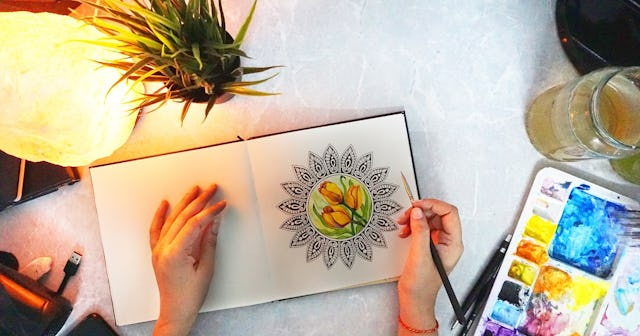11 Mandala Coloring Pages For When You Need More Zen In Your Life

What do you know about mandalas? For many of us, mandalas simply represent cool, repetitive designs that double as an easy DIY activity. On the most basic level, a mandala is a square picture with a circular center (the word mandala translated from Sanskrit means “circle”) that may have four t-shaped “gates,” one on each side. The often symmetrical and highly detailed images are a lot of fun to color. However, it might interest you to know that Hinduism and Buddhism use mandalas as a tool for meditation and helping teach mindfulness. Since we could all use a bit more of both these days, we decided to create a collection of zen-inducing mandala coloring pages.
When adult coloring first rose to popularity, mandalas quickly became an easy coloring subject. You could buy whole “adult coloring books” filled with these circular designs. And why wouldn’t you? It turns out that there are a ton of benefits to coloring as an adult. Some — like sharpening focus and helping you learn how to relax — even directly overlap with the historical uses of mandalas.
Below you’ll find a few of the best mandalas that are free to print and color as many times as you like. We’ve also pulled some more interesting mandala facts and quotes to soothe your frantic mind further. Enjoy!
Free Printable Mandala Coloring Pages
Mandala Page No. 1
“Each person’s life is like a mandala — a vast, limitless circle. We stand in the center of our own circle, and everything we see, hear, and think forms the mandala of our life.” — Pema Chödrön, author and Tibetan Buddhist
Speaking of Buddhism, did you know Buddha was originally a prince? But he left his lavish life to embark on a journey of self-discovery and truth.
Mandala Page No. 2
“When you realize how perfect everything is, you will tilt your head back and laugh at the sky.” — Buddha
While mandalas may have originated from the Sanskrit language, mandala use doesn’t end with Eastern religion. The stained glass of Christian churches often depicts mandalas. Christianity is also one of the largest religions. There are over 2.4 billion Christians in the world!
Mandala Page No. 3
One famous Christian mandala is the Cosmati Pavement at Westminster Abbey. Henry III built (well, commissioned) the piece, and it has been the exact spot of every English and British coronation since. Roman Cosmati artisans designed and laid it, seeming to borrow the style they’d seen echoed throughout the world.
Mandala Page No. 4
“The mandala is a map for spiritual transformation.” — Lama Tsultrim Allione, author and Tibetan Buddhist
Mandala Page No. 5
Mandalas are more than just a pretty patterned picture or relaxing coloring adventure. An authentic mandala is created with the help of geometry and requires a ton of attention to detail. Fun fact: The most common butterfly in the United States is cabbage whites. They’re a combination of white, yellow and green.
Mandala Page No. 6
“The continual stream of new discovery, revelation, and inspiration which arises at every moment is the manifestation of our clarity. We should learn to see everyday life as mandala — the luminous fringes of experience which radiate spontaneously from the empty nature of our being.” — Dilgo Khyentse Rinpoche, Vajrayana master, poet, and scholar
Mandala Page No. 7
Different religions use mandalas differently, too. Typically there are three recognized types of the mandala: the teaching mandala, the healing mandala, and the sand mandala. Teaching mandalas are ultra symbolic, where every line or color represents something important to the creator. Healing mandalas are built more from feeling to channel your thoughts and emotions. Sand mandalas are made by Buddhist monks and used as a religious practice.
Mandala Page No. 8
“The mandala principle expresses the experience of seeing the relatedness of all phenomena.” — Chögyam Trungpa, Tibetan Buddhist meditation master
Mandala Page No. 9
While studying a mandala, you might not recognize any particular shapes or symbols — or you might notice certain elements repeating often. Common shapes found in mandalas are bells, lotus flowers, triangles, and suns.
Mandala Page No. 10
“I saw that everything, all paths I had been following, all steps I had taken, were leading back to a single point — namely, to the mid-point. It became increasingly plain to me that the mandala is the center. It is the exponent of all paths. It is the path to the center, to individuation. I knew that in finding the mandala as an expression of the self, I had attained what was for me the ultimate.” — C. G. Jung, psychiatrist and founder of analytical psychology
Mandala Page No. 11
“In the products of the unconscious we discover mandala symbols, that is, circular and quaternity figures which express wholeness, and whenever we wish to express wholeness, we employ just such figures.” — Carl Yung, Memories, Dreams and Reflections
Click here to print all of the mandala coloring pages at once!
This article was originally published on